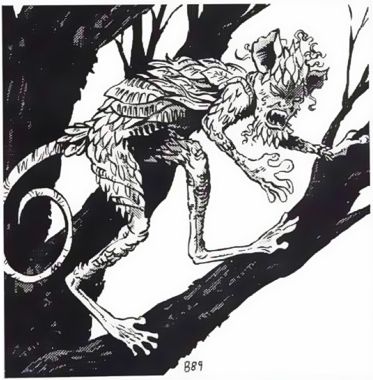

MC Greyhawk Adventures Appendix

| Climate/Terrain: | Tropical to subartic/forests |
|---|---|
| Frequency: | Rare |
| Organization: | Band |
| Activity Cycle: | Night |
| Diet: | Carnivore |
| Intelligence: | Average (8-10) |
| Treasure: | B |
| Alignment: | Neutral evil |
| No. Appearing: | 2-8 |
| Armor Class: | 4 |
| Movement: | 15 (6 climbing) |
| Hit Dice: | 5 |
| THAC0: | 15 |
| No. of Attacks: | 3 |
| Damage/Attack: | 2-5/2-5/1-6 |
| Special Attacks: | See below |
| Special Defenses: | Camouflage |
| Magic Resistance: | Nil |
| Size: | M (6’ tall) |
| Morale: | Steady (11-12) |
| XP Value: | 650 |
Kech are forest fiends that prey on humans and demihumans.
A kech is monkey-like in gait and appearance, with a fang-filled mouth, protruding lower jaw, and fiery blue eyes. The frame is slim and finely muscled. Kech are equally at home in trees or on the ground. Their toes are long and prehensile, enabling them to grasp limbs and swing from branch to branch. In trees kech move 60 feet per round. On the ground, kech run like baboons, using their knuckles and back legs to spring after opponents. Their skin is tough and leathery, with leaf-like wrinkles and a natural green camouflage coloring. Kech have average intelligence but are cunning and crafty. They speak their own language, common, and a smattering of local tongues.
Combat: Kech are wily hunters. They move through forests with a 50% chance of absolute silence. This, combined with their natural coloring, imposes a -5 penalty to opponents’ surprise rolls.
They prefer traps to outright attacks, constructing pit falls, snares, and so forth, to catch unwary travelers or weaken large parties of adventurers. Kech speak common clearly and sometimes fake cries for help to attract their victims. In melee, kech deliver a vicious bite while raking and tearing with their two front claws.
Kech respect but do not fear humans and demihumans. They prefer lone targets but will attack a large, well-armed party at night. During combat, kech usually concentrate on one or two members of the party (most likely the guards), trying to dispatch them quickly before the others awaken. The kech then disappear into the forest dragging their kill with them.
Kech pass through the forest almost without a trace. There is only a 50% chance, at best, of a ranger being able to follow a fresh kech trail (-25% per hour).
Habitat/Society: Kech bands roam all woodlands from tropical rain forests to subarctic pines. A band contains 2d4 adults and 1d3 young (noncombatants).
Kech prey on human and demihuman forest settlements, which they find by tracing trails and paths back to their sources. When a kech band finds a village, they immediately build a tree nest three to five miles away. At night, kech adults leave the nest, prowling along the trails leading into the village, and setting up snares. Their victims are usually lorie workers, wandering elderly, or young couples out on late-night strolls.
Kech hunt an area until they make four or five kills then move on before armed resistance develops. The kech band follows one of the roads leading from the settlement in hopes that it leads to another village.
Young kech cling to the backs their elders while traveling. At night, when the adults hunt, the young stay hidden in carefully camouflaged tree nests. Tree nests are 90% invisible from the ground, so kech rarely leave a guardian behind.
Most kech bands live evil lives. These beasts kill and maim deliberately, terrorizing nearby settlements and tormenting their victims for pleasure before killing them. Occasionally several evil bands join together to rampage through a settlement. These attacks always occur on cloudy or moonless nights. Rampaging bands show no mercy and sometimes slay entire villages.
A few kech bands (10%) may be neutral instead of evil.
Ecology: Neutral kech prey on humans, elves, and half-elves. If starvation is imminent they’ll also eat orcs. Evil kech eat all of the above along with monkeys, gorillas, carnivorous apes, and other kech.
Kech bands keep their numbers small, to match the food source in the area. A band that grows too large will split into two smaller units.
Kech are not deliberately hunted by any carnivore because they are too elusive to provide a steady food source. Still, humans and demihumans sometimes kill kech for their leathery skin. The skin of a kech, when carefully tanned, makes an especially thick and durable set of leather armor (treat as AC 7).
Kech keep no treasure, but their nests sometimes contain items from previous victims. They live 40 years on average.
